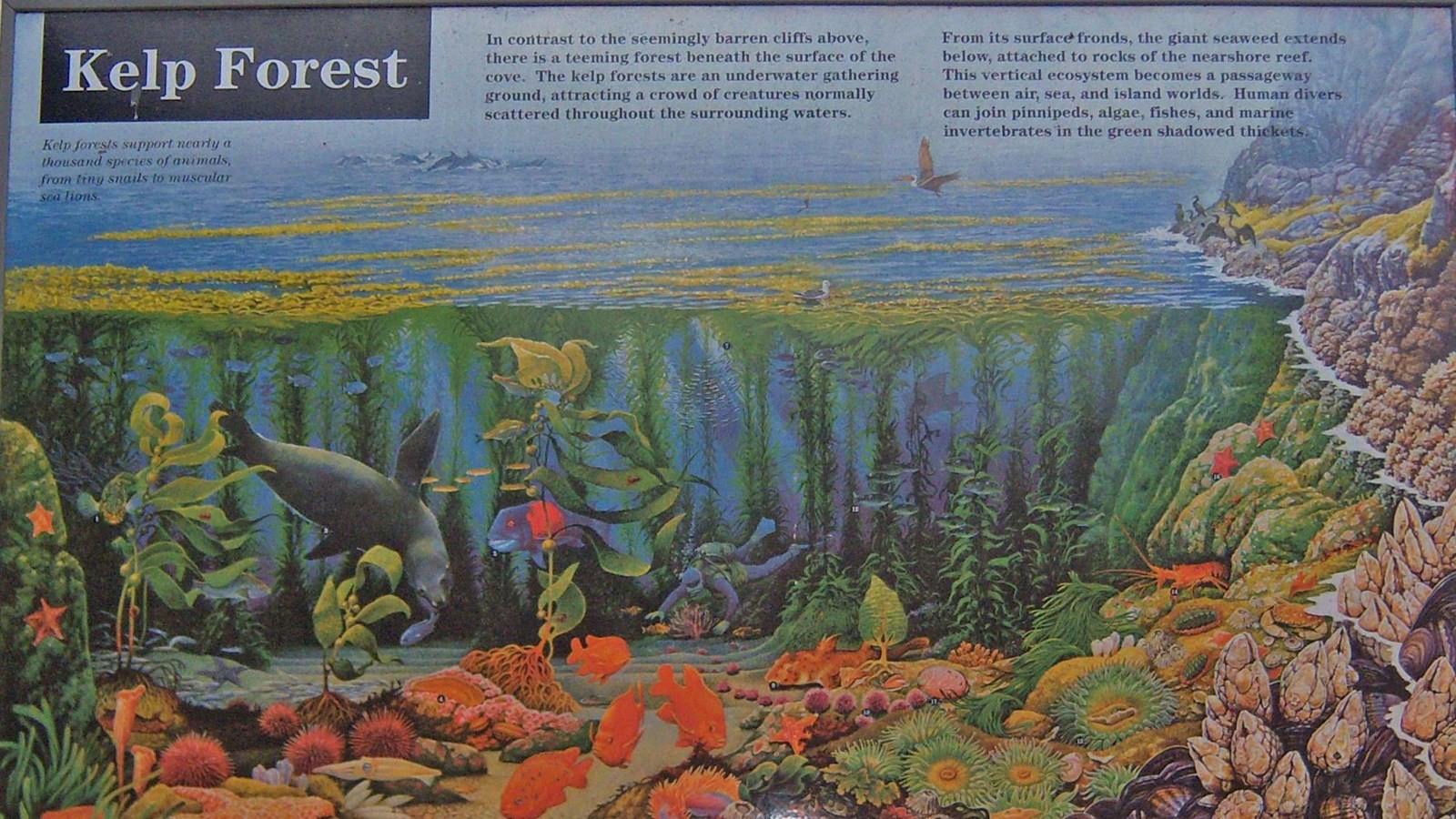Last updated: May 6, 2021
Place
Sign: Anacapa Kelp Forest

Information
Kelp forests support nearly a thousand species of animals, from tiny snails to muscular sea lions.
In contrast to the seemingly barren cliffs above, there is a teeming forest beneath the surface of the cove. The kelp forests are an underwater gathering ground, attracting a crowd of creatures normally scattered throughout the surrounding waters.
From its surface fronds, the giant seaweed extends below, attached to rocks of the nearshore reef. This vertical ecosystem becomes a passageway between air, sea and island worlds. Human divers can join pinnipeds, algae, fishes and marine invertebrates in the green shadowed thickets.
More Information on Kelp Forests and the Marine Environment
The Channel Islands lie within a large embayment known as the Southern California Bight-an area just below Point Conception where the California coastline turns sharply to the east. Within this area, the sea floor is comprised of canyons, banks, escarpments, sea mounts, and deep basins (the Santa Cruz Basin off the island's south coast is deeper than the Grand Canyon). Nutrient-rich waters upwelling from these depths mix and mingle with cool waters from the north (California Current) and warm southern waters (California Countercurrent), creating the Santa Barbara Gyre-a swirling eddy that circulates nutrients and supports a wealth of marine plants and animals, from giant kelp forests and blue whales to tiny crabs and plankton. Here, northern and southern species overlap, creating a transition zone between the Oregonian and Californian marine biogeographic provinces. The western islands harbor numerous northern species, while southern species are more common on the eastern islands.
One nautical mile of water around each island in the park is part of Channel Islands National Park (six nautical miles around each island is part of Channel Islands National Marine Sanctuary).
Within this ocean realm below one may be able to see or hear California sea lions. These playful animals are often spotted around Anacapa's coast, hauled-out on the rocks. Sea lions, along with a variety of other marine species, depend upon the extensive kelp forests that can be found around Anacapa Island and the other Channel Islands. While urban and industrial development has altered much of the southern California mainland coast, the islands contain the most undisturbed stretches of coastline in this region, providing some of the best conditions for kelp forests and their inhabitants.
Kelp is a type of algae that, under ideal conditions (cold, nutrient-rich water), is one of the fastest growing plants on earth-it can grow two feet per day. This foliage provides food, shelter, and protection for over 800 different species-from foraging nudibranchs, to grazing snails, to fish seeking refuge, to whales seeking a plankton snack.
But we must not forget about ourselves. Not only do we feed upon some of the animals that depend upon the kelp forest, but those of us who eat ice cream, salad dressing, and even use tooth-paste are also using a little bit of kelp as well. Kelp is harvested for a natural ingredient called algin, which is used as a suspending, stabilizing, emulsifying, gel-producing, and film-forming additive in more than 70 commercial products. In addition, marine plants such as kelp provide the earth with 80 percent of its oxygen.
Despite these benefits, the kelp forest and its inhabitants are in jeopardy. Pollution and over-harvesting of marine species have completely altered the kelp forest ecosystem. Kelp forests in southern California today cover less than half the area they covered at the turn of the century.
However, with the establishment of Marine Protected Areas (MPAs), improved pollution controls, and fishing regulations, transplantation of kelp, public education, and various research programs some of these problems have been corrected.
Within the park and sanctuary a network of MPAs provide a refuge for sea life and opportunities for recreation, education, and science. In 11 Marine Reserves (including the Anacapa Island Marine Reserve in the waters below you and stretching from Arch Point to Frenchys Cove), recreational fishing and commercial harvest are prohibited; limited fishing and harvest are allowed in the Anacapa Island Marine Conservation Area around the north side of West Anacapa. The MPAs total 318 square miles, the largest such network off the continental United States and part of a larger effort throughout the world to conserve natural, historic, and cultural marine resources.
